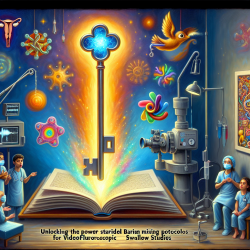As practitioners in the field of speech-language pathology, we continually strive to improve our clinical practices to provide the best outcomes for our patients. One of the gold standards for dysphagia evaluation is the videofluoroscopic swallow study (VFSS). Despite its widespread use, there has been a notable lack of standardization in barium mixing protocols, which can impact the accuracy and reliability of these assessments. A recent study, "The Development of a Standardized Videofluoroscopic Swallow Study Barium Mixing Protocol: A Consensus-Based Approach," addresses this gap by establishing standardized barium mixing protocols for various textures.
In this blog, we will delve into the key findings of this study and discuss how implementing these standardized protocols can enhance your practice.
The Need for Standardization
Videofluoroscopic swallow assessments are crucial for diagnosing and managing dysphagia. However, the lack of standardized barium mixing protocols across different institutions has led to variability in assessment outcomes. This variability can affect the reproducibility and accuracy of the VFSS, ultimately impacting patient care.
The study aimed to establish consensus-based barium mixing protocols for five target textures: thin liquid, nectar thick liquid, honey thick liquid, puree, and solid. By standardizing these protocols, the researchers sought to ensure consistency and reliability in VFSS assessments across different clinical and research settings.
Methodology and Key Findings
The researchers employed a collaborative iterative approach, involving speech-language pathologists from four Canadian acute care centers. They used the International Dysphagia Diet Standardisation Initiative (IDDSI) Flow Test to assess the accuracy of the barium mixing protocols. The iterative feedback process helped identify the most accurate and feasible protocols for each target texture.
- Thin Liquid: The protocol using 135 ml of water and 45 ml of Polibar Plus Barium Sulfate Suspension (105% weight/volume) was found to be the most accurate and feasible.
- Nectar Thick Liquid: The protocol using 120 ml of Sysco Nectar thick liquid, 10 ml of water, and 15 g of EZ HD Barium Sulfate Powder (11% weight/volume) met the IDDSI criteria.
- Honey Thick Liquid: The protocol using 120 ml of Sysco Nectar thick liquid and 48 g of EZ HD Barium Sulfate Powder (36% weight/volume) was standardized.
- Puree: The protocol using 99 g of pudding and 40 g of EZ HD Barium Sulfate Powder (41% weight/volume) was established.
- Solid: A digestive cookie coated with the standardized puree barium solution was selected as the solid texture.
The final protocols were pilot-tested at two of the four participating sites to ensure feasibility and reproducibility. The successful implementation of these protocols demonstrated their potential for widespread adoption in clinical and research settings.
Implications for Clinical Practice
Implementing these standardized barium mixing protocols in your practice can significantly enhance the accuracy and reliability of VFSS assessments. Here are some key benefits:
- Consistency: Standardized protocols ensure that the barium mixtures used in VFSS are consistent across different assessments, reducing variability and improving the comparability of results.
- Accuracy: Accurate barium mixtures that align with the IDDSI criteria provide better visualization during VFSS, leading to more precise assessments of swallow physiology.
- Reproducibility: Standardized protocols facilitate reproducibility, making it easier to track changes in a patient's swallowing function over time.
- Clinical Utility: These protocols are designed to be feasible and practical for use in both clinical and research settings, ensuring that they can be easily adopted and implemented.
Encouraging Further Research
While the study provides a robust framework for standardized barium mixing protocols, further research is needed to validate these findings across different populations and settings. Practitioners are encouraged to contribute to this ongoing research by implementing these protocols in their practice and sharing their experiences and outcomes.
By participating in this collaborative effort, we can collectively improve the accuracy and reliability of VFSS assessments, ultimately enhancing patient care and outcomes.
To read the original research paper, please follow this link: The Development of a Standardized Videofluoroscopic Swallow Study Barium Mixing Protocol: A Consensus-Based Approach.










